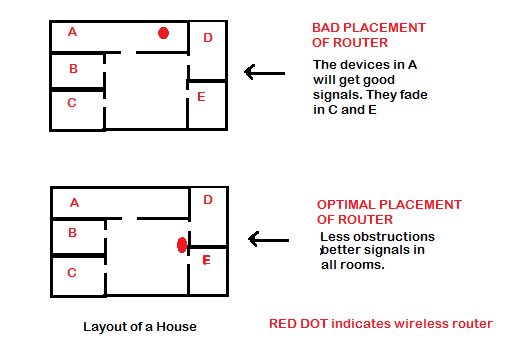A normal WiFi should be able to cover all of your home or office so that you can use it from anywhere and on any devices such as laptops and phones. Not often do you get to use the optimal signal strength of your wireless network? This could be due to various factors I’ve listed below. This article offers assistance to extend the area covered by WiFi signals.
How to increase WiFi Speed and Signal strength
Follow these steps to improve, boost, extend, or increase Wi-Fi router signal and range at home or workplace, without spending anything. But before you begin, you might want to check the speed of your internet first.
- Extend WiFi Signal Area with Better Placement of Router
- Adjust Obstacles for Flow of Signal Strength
- Remove Other Wireless Devices
- Omnidirectional vs. Unidirectional Antennas
- Use Repeaters To Increase WiFi Range
- Upgrade Network Cards and Router.
1] Extend WiFi Signal Area with Better Placement of Router
One of the most important things to think when designing a wireless network is to decide where to keep the router. You would want all corners of your house or office covered so that people can use it from anywhere. For that, you have to check the optimal place for the router. To do this, draw a rough layout of your house on paper. See where and how many walls and other things act as obstructions.
If your router is placed in an inside room and you want to use it outside on the porch, you may not get the wireless signals as the waves are killed by all those walls and furniture, etc. between the router and your porch.

Check out the above image to understand it better. The red dot is the router, and all rooms are marked with alphabets. You can see how the walls and placement create a problem. The layout also shows how to select an optimal position for the router: a place that is almost equidistant from all of your rooms and other areas that you wish covered by WiFi. Just think of the entire coverage area you want and figure out what is the central position which allows proper flow of signals in all directions, to extend the WiFi network range.
Read: Things in your home that can block or obstruct Wi-Fi signal
2] Adjust Obstacles for Flow of Signal Strength
Other than the wall, things like your almirahs, water coolers, and mirrors, etc. weaken and even kill the WiFi signals moving that way. Almirahs are mostly metals that may prevent signals from crossing over through the unit. Water dampens signals of 2.4GHz for some reason. This is the usual frequency used by wireless routers and even other wireless things at your home. Mirrors have a special coating towards the back that absorbs signals of that frequency (2.4GHz).
Just check out if they can be removed from the invisible straight line between your router and the place you wish to use a WiFi device. If yes, you can adjust the items to make it clearer and easier for the wireless signals to pass through. Breaking down walls will further ease the signal flow, but I won’t suggest doing that to increase the signal range! Instead, we’ll talk about repeaters to provide for signal strength loss when they travel through walls.
Read: Improve Wireless Connection Latency with WLAN Optimizer.
3] Remove Other Wireless Devices
As said earlier, the WiFi signals travel at 2.4GHz. I do not know exactly how, but some routers do provide an option of changing the frequency to 5GHz. If you can do that (check your router settings in a browser), nothing can beat that. But if there is no option in the router, try to minimize wireless devices around the router and wireless device you are using on WiFi. Almost all household appliances – including the wireless mouse, wireless printers, and even microwave ovens – run at the said frequency of 2.4GHz. Since you need these devices and cannot get rid of them, just make sure there is minimum interference among all these smart appliances.
TIP: This post will help you if you face slow Internet speed on Windows 10.
4] Omnidirectional vs. Unidirectional Antennas
In the case of the first layout in the image above, if the antenna is omnidirectional, it is wasting half of your WiFi signals by sending them out of the house. In such cases, go for unidirectional antennas. You may combine unidirectional antennas with repeaters to get better WiFi signal strength in other rooms that lie on the other side of the direction set by unidirectional antennas.
5] Use Repeaters To Increase WiFi Range
Some people place the repeaters just at the point where the original wave frequency is very low. That setup, though fine, will not provide you with strong enough signals. Keep the repeaters in the zone and where the signal strengths are still a little strong. That way, you can boost WiFi signals to extend its range.
6] Upgrade Network Cards and Router
WiFi works fine when the router and network cards are of the same type. Routers and network cards are not much expensive. There are many companies selling them under $100 while network cards are somewhere between $30 and $50 (as published on CISCO site). If you are willing to spend money, upgrade to a better network, and see how the change increases your WiFi network coverage area.
Check this if your Windows PC suffers from poor WiFi performance and this to know How To Improve Wireless Network Signal On Windows. Change WiFi Roaming Sensitivity or Aggressiveness to improve Wi-Fi reception & performance.
Read: Is WiFi safe for your health?
Let me know if I missed anything.